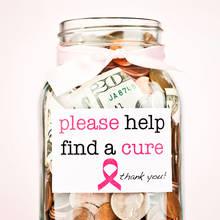In bygone days, October presented itself in orange and black. Autumn leaves swirled in flame-colored piles. Pumpkins, pointy witches’ hats, and dark cats were everywhere, or so it seemed.
Now the hot fall color is pink. Pink ribbons are ubiquitous against nature’s orange-and-black backdrop. And pink wrist bands. And pink football cleats. And pink dresses on Michele Obama and Ann Romney at the second presidential debate. Even Halloween pumpkins are coming up pink all over.
October is National Breast Cancer Awareness month, and unless you have been to Mars during the last few weeks, it’s been hard to miss. Not only breast cancer charities, but also a slew of organizations has slapped pink ribbons on products to advance this popular cause.
For at least a decade, a smattering of groups and individuals has questioned who really profits. Since 2002, Think Before You Pink, a project of Breast Cancer Action, has been urging people to be skeptical before they buy into breast cancer promotions. This year, skeptics are questioning just how much the National Football League takes home after giving the American Cancer Society 5% of its profits on the high-priced pink hats and t-shirts being sold from the Breast Cancer Awareness page at the NFL online store.
Now New York Attorney General Eric T. Schneiderman has entered the fray with a best practices model for pink ribbon–style blends of commerce and charity. The best practices are designed "to promote transparency in charitable ‘cause marketing’ campaigns, a growing billion-dollar-a-year industry in which companies advertise that the sale or use of a product will result in a charitable contribution," according to a statement from Mr. Schneiderman.
His list follows a year-long review of pink ribbon and similar campaigns waged by nearly 150 companies. "While these campaigns have resulted in substantial donations, the attorney general’s review found that consumers often do not have sufficient information to understand how their purchases will benefit charity," the statement said.
The complete best practices and other guidance can be found here. Here, in short, is what the A.G. wants companies to do before they raise money in the name of breast cancer or any other cause:
• Clearly describe the promotion. Promotions should tell the name of the charity; the specific dollar amount per purchase that will go to charity; any caps on the donation; whether any consumer action is required to trigger a donation; and the start and end dates of the campaign.
• Make it easy to determine the donation amount. Companies should set a fixed dollar amount, such as 50 cents for every purchase, rather than use generic phrases like "a portion of proceeds" will go to charity.
• ‘Be transparent about what is not apparent.’ Conditions that are not obvious to consumers should be disclosed. Does the campaign have a contractual limit on the campaign? Will charitable contributions not be made in cash? Has a fixed amount been promised to the charity regardless of the number of products sold?
• Be transparent in social media. Sometimes a company promises to contribute to a cause for a "like" on Facebook or a "follow" on Twitter. The company should disclose how much it will donate for the action, the name of the recipient charity, when the campaign starts and ends, and whether there is a minimum or maximum amount it will donate. And it should be easy to see how much has been donated to date.
• Disclose how much money was raised. When the campaign is over, the company should say so – and tell everyone how much it gave to charity.
Finally, if all that is not clear enough, Mr. Schneiderman proposes a "Donation Information" label – similar to a nutrition label – that could be slapped on any product or website running a campaign.
So far, the Susan G. Komen for the Cure and Breast Cancer Research Foundation have signed on, the A.G. said. Who else is ready to show their true colors?


